Введение
RDP (Remote Desktop Protocol) — это протокол, разработанный компанией Microsoft, который позволяет удаленно подключаться к компьютеру с Windows с другой машины. Это может быть полезно для оказания технической поддержки, доступа к файлам на удаленном компьютере или просто для работы на нем из удаленного места.
В этом руководстве мы расскажем, как подключиться к компьютеру с Windows с устройства Linux.
Предварительные условия
- Компьютер с Windows, настроенный для удаленного доступа RDP.
- Компьютер с Linux.
- Клиент RDP для Linux.
Настройка компьютера с Windows
- Разрешить удаленный доступ RDP:
- Откройте «Система» > «Удаленный доступ».
- В разделе «Удаленный доступ к этому компьютеру» поставьте флажок «Разрешить удаленные подключения к этому компьютеру».
- Нажмите «Применить» > «ОК».
Как можно открыть вкладку «Система»
Вам понадобится открыть » Панель управления»
Выбрать «Система безопасности»
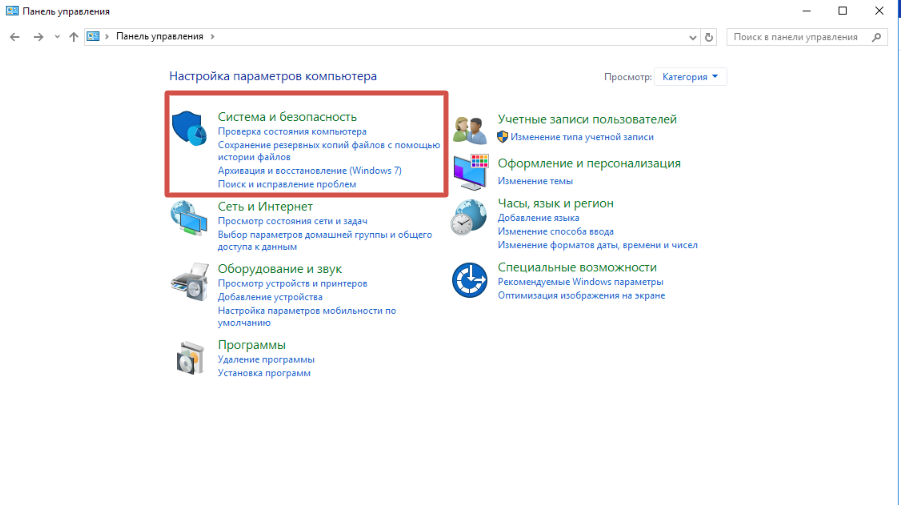
Выбрать вкладку «Система»
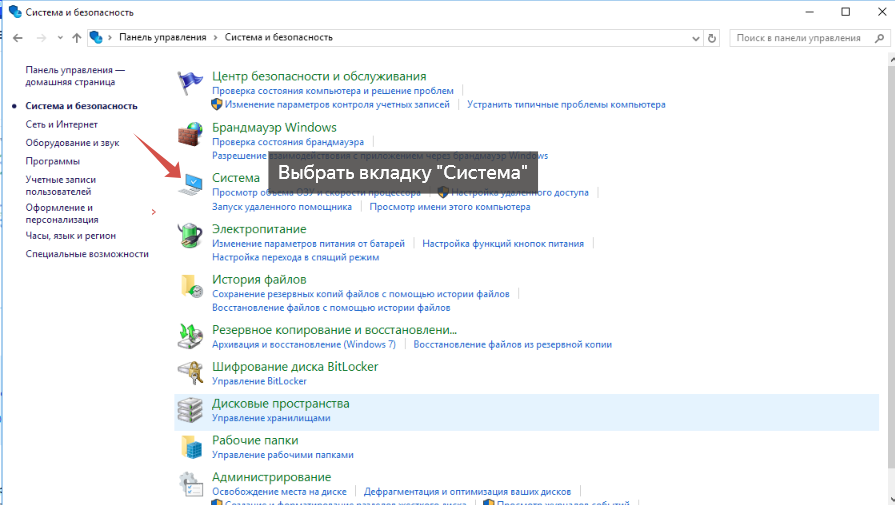
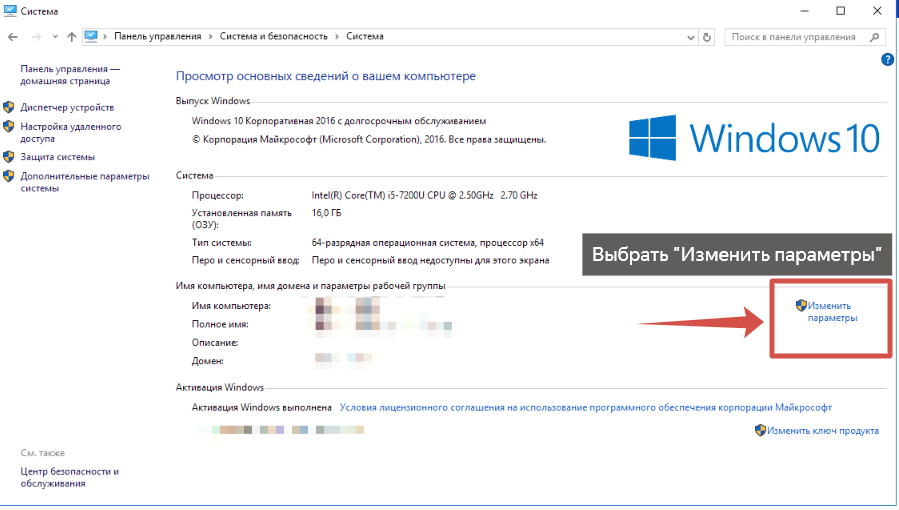
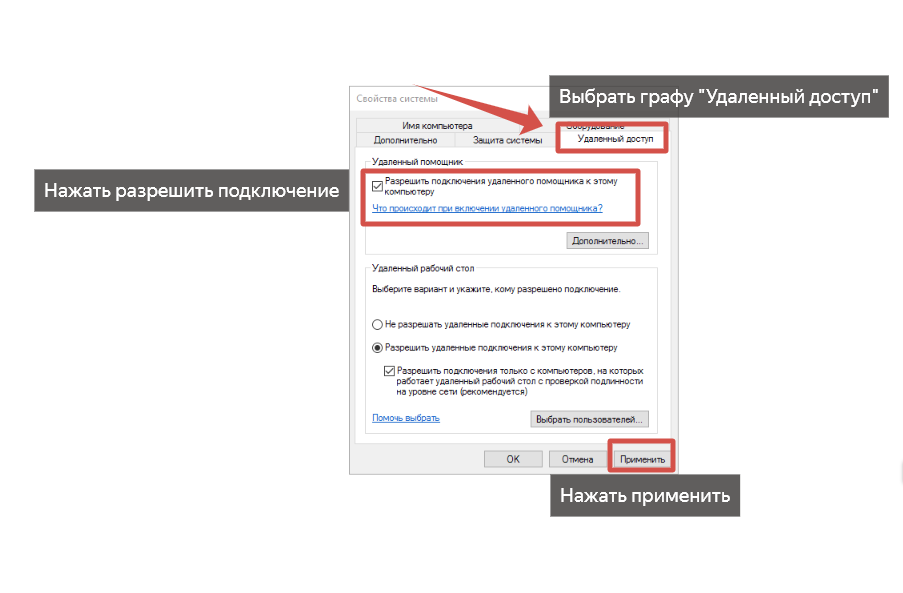
2. Назначьте пользователей RDP:
-
- Откройте «Система» > «Свойства системы».
- На вкладке «Удаленный доступ» нажмите «Выбрать пользователей».
- Добавьте пользователей, которым вы хотите разрешить удаленный доступ, и нажмите «ОК».
Настройка компьютера с Linux
- Установите RDP-клиент:
- В зависимости от вашего дистрибутива Linux вам потребуется установить RDP-клиент.
- Ubuntu/Debian: Remmina, XRDP
- Fedora/CentOS: Remmina, xrdp
- Arch Linux: rdp, xfreerdp
- В зависимости от вашего дистрибутива Linux вам потребуется установить RDP-клиент.
- Запустите RDP-клиент:
- Найдите и запустите установленный вами RDP-клиент.
Подключение к компьютеру с Windows
- Введите IP-адрес или имя компьютера с Windows:
- В RDP-клиенте введите IP-адрес или имя компьютера с Windows, к которому хотите подключиться.
- Введите имя пользователя и пароль:
- Введите имя пользователя и пароль учетной записи Windows, имеющей разрешение на RDP-доступ.
- Нажмите «Подключиться»:
- Нажмите кнопку «Подключиться», чтобы начать RDP-сеанс.
Дополнительные сведения
- Настройка параметров RDP:
- Большинство RDP-клиентов позволяют настраивать различные параметры подключения, такие как разрешение экрана, качество изображения и т. д.
- Использование перенаправления устройств:
- RDP позволяет перенаправлять локальные устройства, такие как принтеры и диски, на удаленный компьютер.
- Решение проблем с RDP:
- Если у вас возникли проблемы с подключением к компьютеру с Windows по RDP, ознакомьтесь с разделом устранения неполадок в документации вашего RDP-клиента.
2.2. Настройка файерволла в ЕСУ
Примечание!
Опасно держать открытым RDP в Интернет, на долгий промежуток времени.
Риски
Чем вы рискуете открывая порт RDP?
1) Неавторизованный доступ к чувствительным данным
Если кто-то подберёт пароль к RDP, то он сможет получить данные, которые вы хотите держать приватными: состояние счетов, балансы, данные клиентов, …
2) Потеря данных
Например в результате работы вируса-шифровальщика.
Или целенаправленного действия злоумышленника.
3) Потеря рабочей станции
Работникам нужно работать, а система — скомпрометирована, нужно переустанавливать / восстанавливать / конфигурировать.
4) Компрометация локальной сети
Если злоумышленник получил доступ к Windows-компьютеру, то уже с этого компьютера он сможет иметь доступ к системам, которые недоступны извне, из Интернета. Например к файл-шарам, к сетевым принтерам и т.д.
и еще многие другие риски вас могут ожидать!
Дополнительные сведение:
Можно установить на вашу ВМ, П/О IPban, оно поможет сократить не желательные подключение.
https://github.com/digitalruby/ipban
Так же рекомендация переименовать пользователя- Administrator в другое имя, т.к нельзя его удалить, если он у вас оставлен и существует. Это упрощает задачу для злоумышленников: вместо подбора имени и пароля нужно только подобрать пароль.
Ссылки
- Настройка удаленного доступа к компьютеру в Windows: https://learn.microsoft.com/ru-ru/windows-server/remote/remote-desktop-services/clients/remote-desktop-allow-access
- Подключение к удаленному рабочему столу в Windows с помощью клиента RDP: https://learn.microsoft.com/ru-ru/windows-server/remote/remote-desktop-services/clients/windows
The Remote Desktop Protocol (RDP) allows users to connect to another computer across a network and take remote control over the host machine.
The remote desktop connection is possible between different platforms, e.g., Linux users are able to RDP into a Windows system and vice versa.
Learn how to RDP to a Windows PC from your Ubuntu system in minutes.
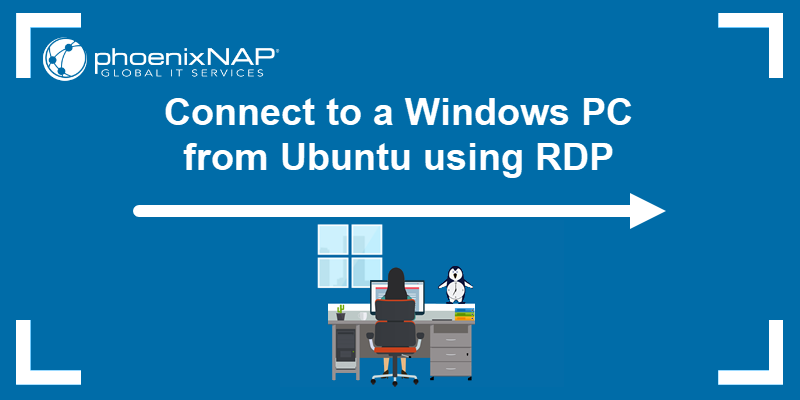
Prerequisites
- Ubuntu system.
- Sudo or root privileges.
- A remote Windows machine with network connectivity.
- Windows firewall set to allow incoming RDP connections.
- The user account intended for the RDP session with RDP permissions on the Windows system.
How to Connect to a Windows PC From Ubuntu
The Ubuntu (client) and Windows (host) systems must be configured before establishing an RDP connection. This configuration ensures the Windows system allows remote desktop connections and the Ubuntu client has the necessary software to initiate the connection securely.
Enable Remote Desktop Connection on the Windows Computer
Incoming RDP connections must be enabled on the Windows system. There are two ways to enable RDP in Windows.
Option 1: Enable RDP in Settings
To enable RDP in Windows settings, take the following steps:
1. Open the Windows Start menu and select Settings.
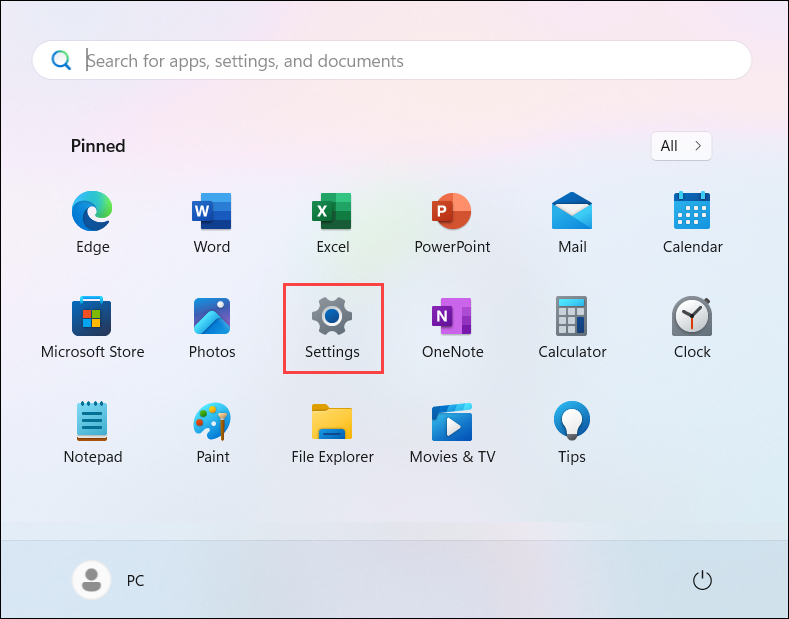
Note: Alternatively, press Winkey+I to access the Settings app.
2. Select System.
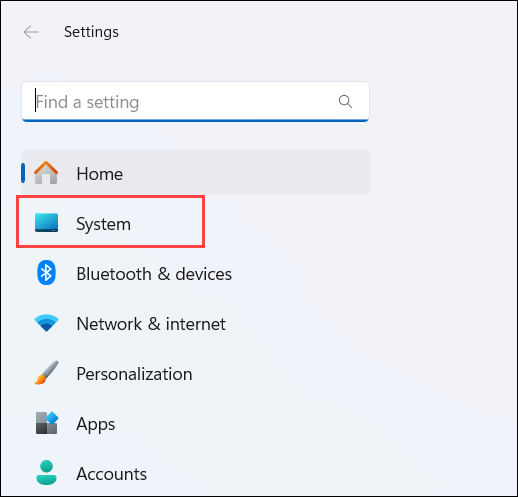
3. Scroll down and locate Remote Desktop in the menu.
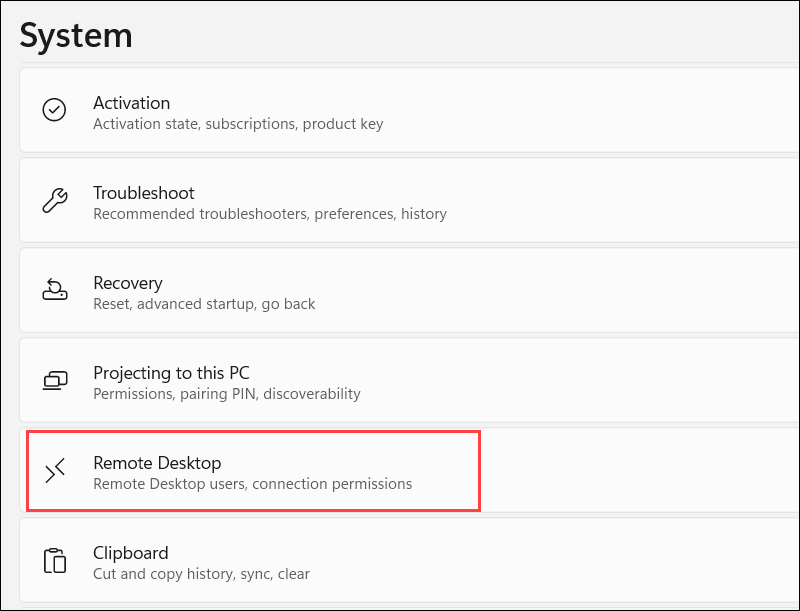
4. Toggle the Enable Remote Desktop switch On.
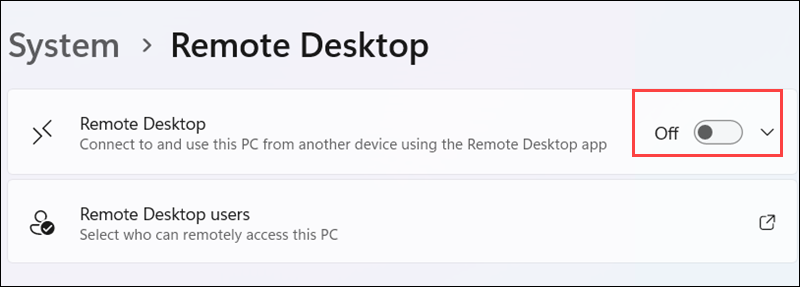
5. Click Confirm.

6. Close the Settings menu.
Note: When enabling RDP, ensure the user account initiating the connection has RDP permissions and the firewall allows RDP connections.
The Windows PC now accepts RDP connections.
Option 2: Enable RDP from Windows CMD
Activating RDP via the Windows Command Prompt (CMD) is useful when automating RDP setups across multiple Windows machines or creating scripts to streamline the configuration process.
To accomplish this, take the following steps:
1. Type cmd in the Windows search box.
2. Select Run as administrator to open the Command Prompt with administrative privileges.
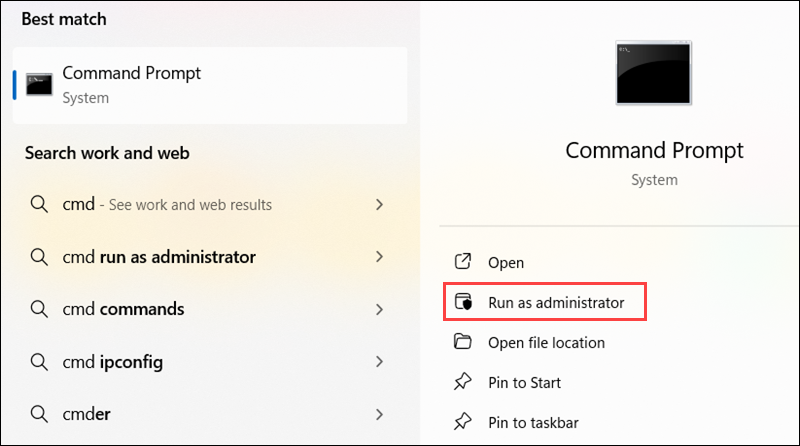
3. The reg command modifies the Windows Registry. Enter the following command to enable RDP:
reg add "HKEY_LOCAL_MACHINE\SYSTEM\CurrentControlSet\Control\Terminal Server" /v fDenyTSConnections /t REG_DWORD /d 0 /f
Warning: Exercise caution when making changes to the Windows Registry. Incorrect modifications harm your system.
4. This part is optional, but if the Windows Firewall is activated, use the following command to enable RDP connections:
netsh advfirewall firewall set rule group="remote desktop" new enable=Yes
Note: The user account used to establish the connection must have RDP permissions on the Windows machine, and the Windows firewall must allow RDP connections.
The Windows system is ready to accept RDP connections.
Install Desktop/GUI Environment on Ubuntu (Optional)
Users running Ubuntu Server or a minimal installation of Ubuntu without a graphical user interface (GUI) often use command-line-based RDP clients, such as FreeRDP. However, some RDP clients like Remmina do not work without a GUI.
Installing a GUI on Ubuntu, such as Ubuntu GNOME, KDE Plasma, LXDE, or XFCE, provides a more intuitive and user-friendly environment for establishing RDP connections.
To install the GNOME desktop environment:
1. Update the Ubuntu packages list:
sudo apt update2. Enter the following command to install GNOME:
sudo apt install ubuntu-desktop -y3. Reboot the system:
sudo rebootOnce you log in to the Ubuntu system, you are presented with a desktop environment.

Next, install and launch your preferred RDP client to connect to the Windows system.
Install Remote Desktop Client Software on Ubuntu
Linux users utilize RDP clients such as Remmina, FreeRDP, or others to facilitate an RDP connection.
The following text presents how to install remote desktop client software on Ubuntu.
Option 1: Install Remmina Client on Ubuntu
Remmina is the default RDP client on newer Ubuntu systems. To check if the Remmina client is installed, use dpkg piped with grep:
dpkg -l | grep remmina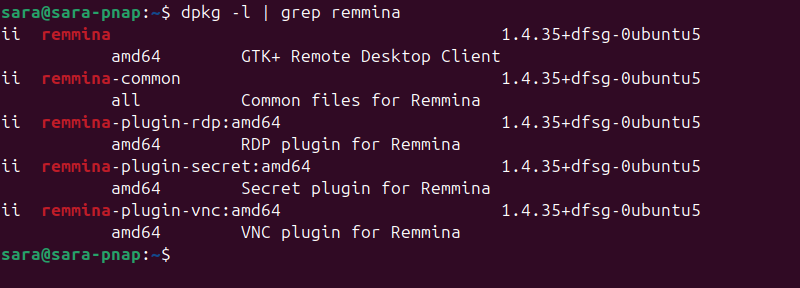
The system displays a list of installed Remmina packages and plugins. If the Remmina client is not installed, take the following steps:
1. Update the Ubuntu packages list:
sudo apt update2. Install Remmina and the necessary plugins:
sudo apt install remmina remmina-plugin-rdp -y
3. Launch the RDP client by entering the following command:
sudo remmina4. Click the top left + icon to add a new connection profile.
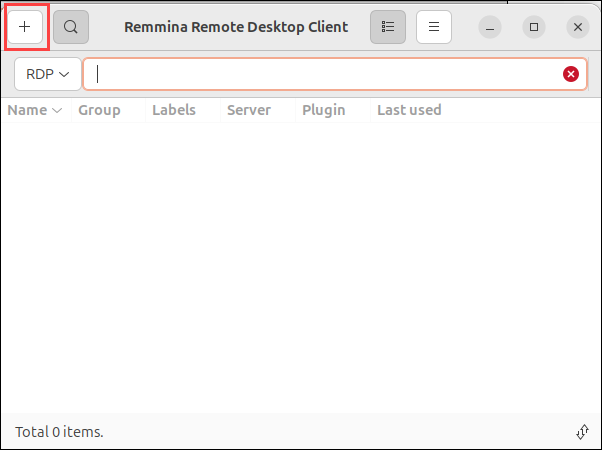
5. Enter a connection profile Name. For example, Windows PC Connect.

6. Select RDP — Remote Desktop Protocol from the Protocol dropdown menu.

7. Enter the IP address or hostname of the Windows machine in the Server field.
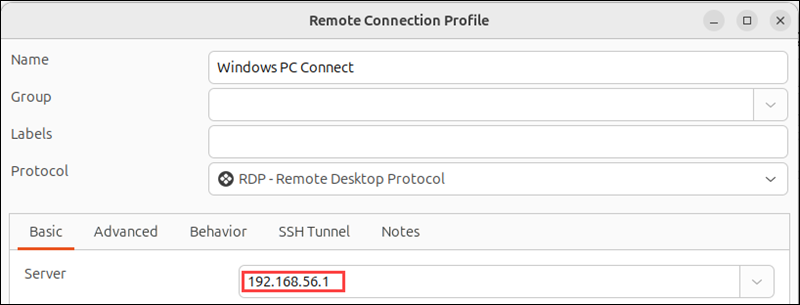
Note: Find the IP address of the Windows machine using the ipconfig command. Look for the IPv4 Address under your active network connection.
8. Define the username and password for the user account you plan to use to log into the Windows machine.
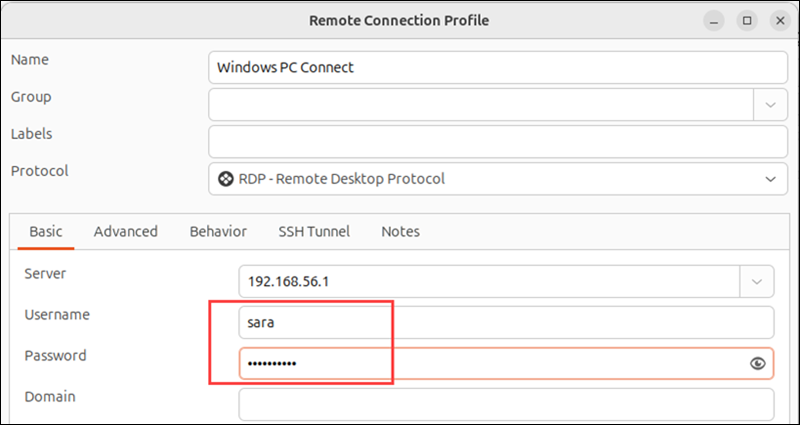
Note: This user should be granted RDP permissions on the Windows host.
9. Select Use client resolution or define a custom resolution in the Resolution field.
10. Leave the Colour depth set to Automatic. This preference allows the server to choose the best format based on network speed.
These are the mandatory options for initiating a standard RDP session. The Remmina client has numerous advanced settings to customize how the RDP connection is established.
11. Click Save and Connect to save the profile and connect to the Windows machine using the profile details.
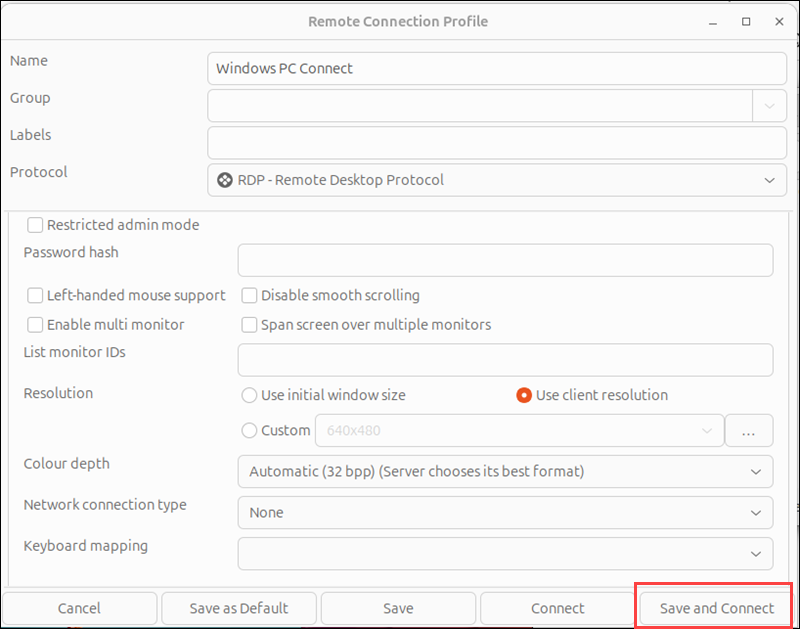
Note: If you receive a certificate warning, opt to trust the (legitimate) certificate to continue with the connection.
The remote Windows desktop is available in the Remmina dashboard.
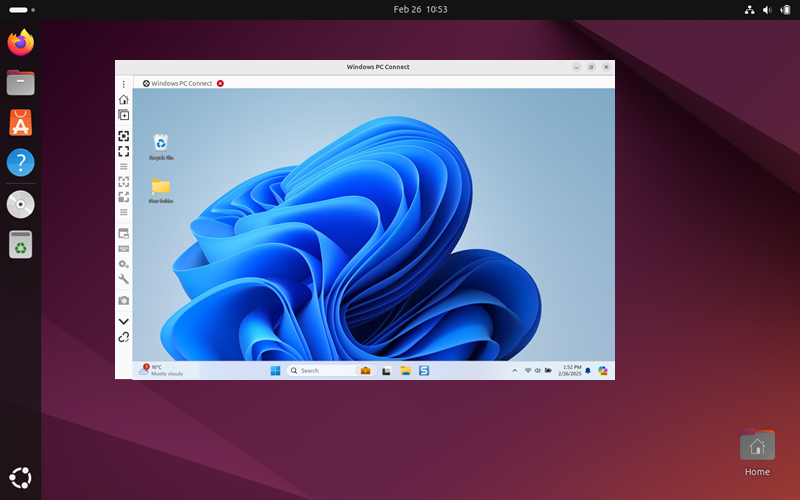
The next time to RDP into the Windows system, launch Remmina and double-click the saved profile.
Option 2: Install FreeRDP Client on Ubuntu
FreeRDP is an open-source Remote Desktop Protocol (RDP) client that allows Ubuntu to connect to Windows using the terminal. It is often preferred over graphical clients like Remmina for its flexibility, lower resource usage, and ability to be scripted for automation or remote administration.
To install the FreeRDP client on Ubuntu:
1. Update the Ubuntu packages list:
sudo apt update2. Install the FreeRDP client using the following command:
sudo apt install freerdp2-x11 -y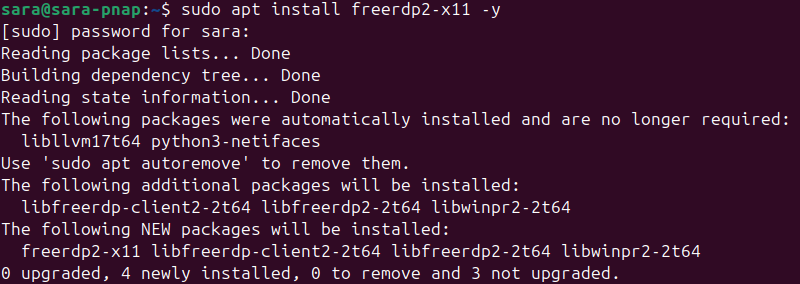
3. Establish the RDP connection using the following syntax:
sudo xfreerdp /v:windows_machine_ip /u:usernameReplace windows_machine_ip and username with valid connection details. In this example, those are:
sudo xfreerdp /v:192.168.56.1 /u:PCIf the password /p: option is not included in the command, xfreerdp prompts for the RDP user password. This practice is more secure than entering the password within the command.
Note: To find the windows_machine_ip, run the ipconfig command. Moreover, to find username, run echo %USERNAME% in the command prompt.
Once connected via FreeRDP, the user gains access to the remote Windows system in a graphical interface.
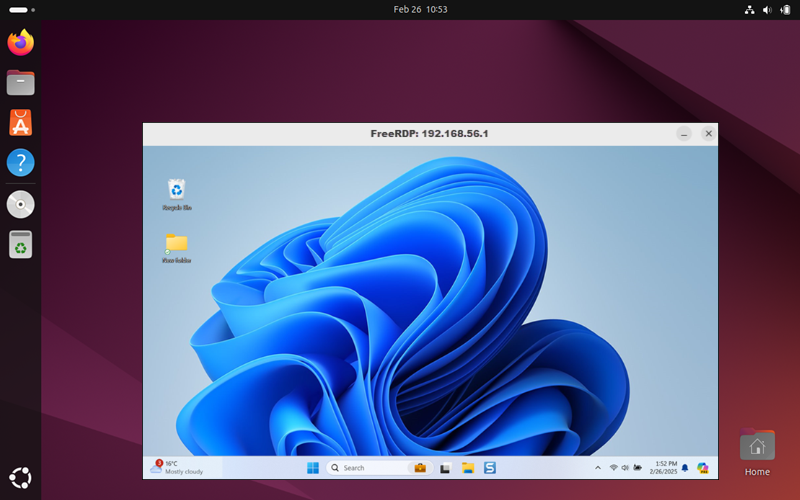
The xfreerdp command-line tool is part of the FreeRDP project and offers multiple options for connecting to RDP servers:
| OPTION | DESCRIPTION |
|---|---|
/p:[password] |
Specifies the user’s password. |
/domain:[yourdomain] |
Specifies the domain for authentication. |
/f |
Enables fullscreen mode. |
/size:[1366x768] |
Specifies a custom screen resolution. |
/port:[4309] |
Specifies a port number other than the default 3389. |
Ubuntu RDP to Windows: Extra Tips + Best Practices
To ensure a secure Remote Desktop Protocol (RDP) connection from Ubuntu to Windows, carefully consider performance and security settings. By optimizing hardware, network speed, and display settings, users enhance responsiveness and reduce lag during remote sessions.
The sections below offer advice on how to achieve optimal results when connecting to Windows using RDP on Ubuntu.
Minimum vs. Optimal Hardware Requirements
The RDP experience depends on bandwidth, network latency, and the capabilities of the Windows host machine. The table below outlines the minimal and optimal requirements for the Ubuntu and Windows systems:
| Hardware | Ubuntu Client Minimal / Optimal |
Windows Host Minimal / Optimal |
|---|---|---|
| CPU | Dual-core processor / Multi-core processor | 1 GHz dual-core / 2.4 GHz+ multi-core |
| RAM | 2 GB / 4 GB+ | 4 GB / 8 GB+ (16 GB+ for heavy tasks) |
| Graphics | Integrated GPU / Dedicated GPU (for graphics-intensive tasks) | DirectX 12-compatible GPU / Dedicated GPU for demanding applications |
| Network | 5 Mbps / 20 Mbps+ | 5 Mbps+ / 20 Mbps+ |
| Disk | Sufficient memory for RDP client software / SSD | 64 GB storage (minimum) / SSD highly recommended |
Use the information in the table as a broad guideline. Actual requirements depend on the specific tasks performed during the RDP session.
Implement Security Measures
To enhance the security of an RDP session from Linux to Windows, implement security measures on the Windows side, Linux side, and the network. The lists below offer useful tips for each security segment.
Windows
- Limit the number of user accounts that can establish an RDP connection.
- Create dedicated accounts for RDP to restrict access to critical systems or data.
- Enforce strong password policies for RDP user accounts.
- Implement two-factor authentication (2FA) for RDP sessions.
- Activate Network Level Authentication (NLA) to require authentication before establishing a session.
- Temporarily lockout user accounts after multiple unsuccessful login attempts.
The network
- Use a firewall to restrict RDP access to specific IP addresses.
- Change the default RDP port (3389) to a non-standard port number to mitigate brute-force attacks.
- Use a VPN to encrypt the data transfer between client and host machines.
- Alternatively, use SSH port forwarding to create an encrypted tunnel for the RDP session if a VPN is not an option.
Linux
- Regularly update the RDP Client to the latest version to benefit from security patches and improvements.
- Disconnect from an RDP session when it is not being used and set timeouts for idle sessions.
- Limit the number of simultaneous active sessions.
Ideal Internet Speed for RDP Connections
RDP is efficient even over slower connections. However, specific tasks require a minimal level of visual quality and responsiveness.
The table offers an overview of minimal and recommended bandwidth for general RDP tasks:
| Task | Minimum Bandwidth | Recommended Bandwidth |
|---|---|---|
| Text-based tasks | 1 Mbps | 2 — 5 Mbps |
| MS Office and Web browsing | 3 — 5 Mbps | 10 — 15 Mbps |
| Design, images, and video | 10 — 15 Mbps | 25 — 50 Mbps+ |
| Concurrent RDP Sessions | Allocate bandwidth for each concurrent session. | Allocate bandwidth for each concurrent session. |
Keep in mind that apart from bandwidth, server loads, network latency, and stability affect RDP performance.
Test the RDP performance under typical work conditions and adjust RDP and network settings to balance responsiveness and quality.
Reduce Resolution and Color Depth for Performance Boost
Controlling the amount of detail an RDP client transfers over the network produces significant performance gains. Read the sections below to learn how to adjust resolution and color depth in your RDP session.
Reducing the Resolution of an RDP Session
Lowering the screen resolution or window size in RDP sessions means fewer pixels are transferred over the network. This strategy improves responsiveness and speed when bandwidth is limited.
RDP clients enable users to set the screen resolution when initiating an RDP session. For instance, with FreeRDP, use the following command to set a 1280×720 resolution:
sudo xfreerdp /v:windows_machine_ip /u:username /size:1280x720Reducing the resolution enhances speed but also compromises visual quality.
Lowering Color Depth of an RDP Session
Color depth defines how sharply a system represents or distinguishes unique colors.
Lowering the color depth reduces the amount of data transmitted for each pixel. The session is more responsive, but colors may seem off, and gradients might lose their smoothness.
In the Remmina client, the Color depth option lets users define the color depth for the RDP session.
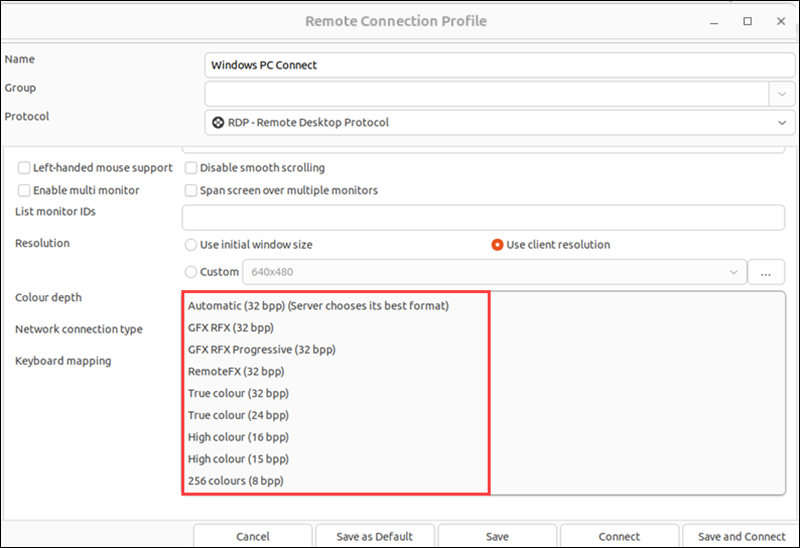
A low depth works for simple tasks like text editing, but the True color setting, with 32 bits per pixel, provides the high-quality visuals required for video playback or graphic design.
Conclusion
This article explained how to use an RDP client to connect to a remote Windows PC from your Ubuntu system. Use this tool to administer remote Windows systems, provide technical support to Windows users, and operate Windows-specific tools and applications.
Next, learn how to access an Ubuntu PC via Remote Desktop from Windows.
Was this article helpful?
YesNo
Время на прочтение10 мин
Количество просмотров305K
Создавая виртуальный сервер на VPS.house, вы получаете полностью 100% готовую к использованию операционную систему Windows Server, к которому сразу же можно подключаться по сети с любого внешнего устройства по протолку RDP.
RDP (Remote Desktop Protocol) – специальный протокол, разработанный компанией Microsoft для удаленного управления ОС Windows (протокол удалённого рабочего стола). Изначально, разумеется, как и многие вещи под Windows, этот протокол разработали другие люди, но в настоящее время поддерживает его и развивает Microsoft.
Согласно условиям лицензирования, ОС Windows Server допускает по умолчанию не более 2-х одновременных подключений по RDP к серверу, если нужно больше, то понимается терминальный сервер и лицензируется либо количество пользователей, либо количество подключаемых устройств. Но, подключившись к серверу по RDP, вы также можете поставить любое удобное вам решение для удалённого управления рабочим столом: TeamViewer, RAdmin и прочие.
Данная статья описывает процесс подключения к серверу Windows по RDP с многих популярных операционных систем. Ввиду этого получилась она довольно длинной. Моментально перейти к нужному вам разделу вы можете по этому меню:
Подключение в VPS серверу из десктопной Windows
Данная инструкция проверена и работает успешно на всех популярных версиях Windows для персональных компьютеров: XP, Vista, Windows 7, 8, 8.1 и 10.
В каждой операционной системе Windows есть встроенное приложение для подключения по RDP – это программа «Подключение к удалённому рабочему столу» (Remote Desktop Connection в англоязычных ОС).
Для запуска ее зайдите по пути:
Пуск -> Программы -> Стандартные -> Подключение к удалённому рабочему столу
Если вы используете Windows 8, тогда:
Пуск -> Приложения -> Подключение к удалённому рабочему столу
Если вы используете Windows 10, тогда:
Пуск -> Все приложения (может этого пункта не быть!) -> Стандартные Windows -> Подключение к удалённому рабочему столу
Или же просто нажмите комбинацию клавиш Win+R и в открывшемся окне наберите mstsc

В открывшемся окне наберите IP-адрес вашего виртуального сервера и нажмите кнопку «Подключить». IP-адрес сервера вы можете видеть в вашем личном кабинете в разделе «Мои серверы»:


Если вы заказали сервер с 2-я или большим количеством IP-адресов, то для подключения к серверу вы можете использовать любой из них – это ни на что не влияет.
Те, кто впервые стакиваются с созданием удалённого рабочего стола, часто задаются вопросом «Зачем нужны эти IP-адреса и сколько нужно именно им», часто также путают количество IP-адресов с количеством рабочих столов или учётных записей, или полагают, что если зайти на сервер по одному адресу, то открывая браузер именно этот адрес будет браузер использовать. Нас самом же деле это всего лишь список внешних адресов, по которому можно подключиться к серверу, сама работа на сервере уже после подключения никаким образом не меняется.
Чаща всего при подключении по умолчанию настроена автоматическая передача данных из буфера обмена, а также подключаются к серверу и становятся на нём видны локальные диски устройства, с которого вы подключаетесь. При сразу после нажатия на кнопку «Подключить» вы можете увидеть уведомление о возможном вреде, который может нанести как удалённый компьютер вашему, так и ваш удалённому. Такое вполне возможно если вы подключаетесь к чужому серверу, на котором могут быть вирусы или вы подключаетесь к своему проведенному серверу с чужого заражённого ПК.
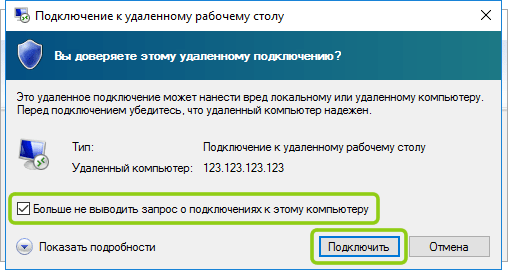
Подключаясь к только что созданному и чистому серверу можно смело отключить дальнейшие уведомления и продолжить процесс подключения.
Далее вы увидите окно с вводом авторизационных данных:
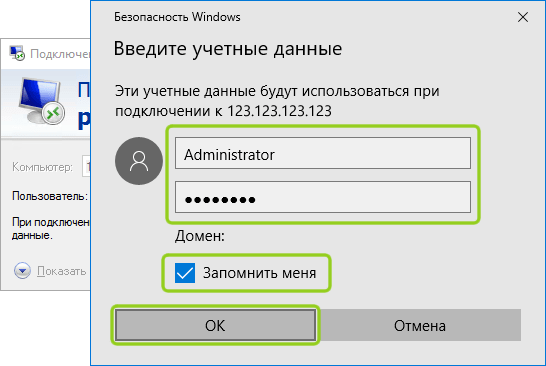
При создании каждого нового сервера система VPS.house автоматически генерирует новый уникальный пароль для него, при этом на всех серверах Windows по умолчанию остаётся имя пользователя Administrator. Пароль от сервера отображается также в личном кабинете возле вашего сервера на странице «Мои серверы»:

В целях безопасности, по умолчанию пароль от сервера скрыт и отображается только по нажатию на ссылку «Показать пароль», при этом сайт попросит вас ввести пароль от вашей учётной записи на VPS.house.
Обратите, пожалуйста, внимание на то, что очень часто при попытке подключения с Windows 7 если копировать и вставлять пароль, система показывает ошибку о неверно введённых учетных данных, тоже самое может возникать и в других версиях. Если вы с этим столкнулись, просто
введите пароль вручную
и обязательно с учётом регистра (заглавные буквы вводите заглавными, а строчные строчными и строго в английской раскладке клавиатуры).
После успешной авторизации перед началом сессии вы получите уведомление о неуспешной проверке подлинности удаленного компьютера. Причина этого уведомления в том, что сессия на стороне сервера шифруется по умолчанию с помощью SSL-сертификата, который сгенерировал сам же сервер, а не тем, что мог быть выдан авторизованным центром сертификации.

Данное уведомление не говорит о проблемах безопасности, и вы смело можете отключить его для будущих подключений к этому же серверу, отметив галочкой «Больше не выводить запрос о подключениях к этому компьютеру».
Если вы используете для работы Windows XP и при подключении система выдает ошибку с текстом «Удаленный компьютер требует проверку подлинности на уровне сети, которую данный компьютер не поддерживает», значит на ваш ПК очень сильно устарел и нужно дополнительно установить небольшое обновление, где его взять и как установить
мы подробно расписали здесь
.
Встроенная программа подключения к удалённому рабочему столу позволяет с лёгкостью передавать файлы на сервер, копируя их на вашем ПК и вставляя в любую папку уже на самом сервере и наоборот. Помимо этого, можно включить передачу на сервер практически любых USB-устройств и сетевых принтеров и сканеров.
Для включения этих возможностей перед подключением к серверу нажмите на кнопку «Показать параметры»:

Откроется режим расширенных настроек подключения к вашему VDS серверу. Перейдите на вкладку «Локальные ресурсы» и отметьте галочкой требуемые для вас устройства:

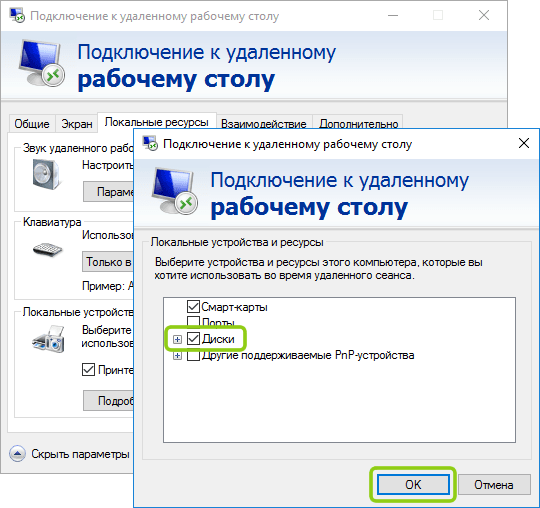
Еще одна очень полезная и популярная функция – это возможность создать готовый файл подключения (так называемый «ярлык»), в котором уже сохранены все нужные вам настройки и данные авторизации на сервере. Это особенно удобно если вы хотите дать доступ сотруднику, который не является опытным пользователем ПК.

Для этого также в расширенных настройках подключения на вкладке «Общие» введите имя пользователя (на серверах VPS.house это всегда по умолчанию Administrator), отметьте галочкой «Разрешить мне сохранять учетные данные», чтобы не приходилось вводить пароль каждый раз и, по завершению внесения всех нужных вам остальных параметров подключения (если таковые есть), нажиме кнопку «Сохранить как»:

В итоге вы получите готовый файл с подключением, который вы можете отправить вашему коллеге и тот в свою очередь подключится к серверу 2-я простыми кликами по нему мышкой.
В целях безопасности по умолчанию в данный файл не будет добавлен пароль от учётной записи, он будет запрошен при первом подключении.
Как подключиться к серверу по RDP если вы работаете с Ubuntu
Протокол подключения к уделённому рабочему столу Windows (RDP) – это закрытый протокол компании Microsoft, официальных служб под операционные системы Linux Microsoft не выпускает, но так или иначе уже давно существуют стабильно работающие решения, которые в последних редакциях Ubuntu даже включены в изначальную сборку.
Речи идет о клиенте под названием Remmina
По умолчанию если Remmina включена в вашу сборку, вы можете найти ее в Поиске по запросу «Remote Desktop Client», если ее нет, то установите ее при помощи следующих команд в Терминале.
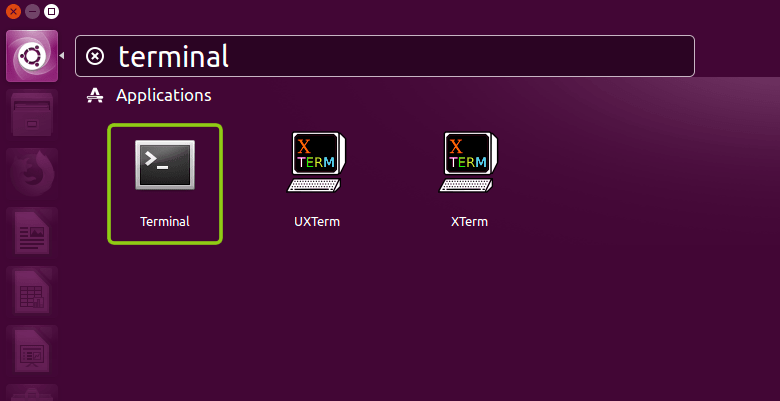
- Устанавливаем пакет Remmina
sudo apt-add-repository ppa:remmina-ppa-team/remmina-next - Устанавливаем обновления
sudo apt-get update - Устанавливаем плагин протокола RDP
sudo apt-get install remmina remmina-plugin-rdp libfreerdp-plugins-standard - Если ранее у вас уже была установлена какая-либо версия Remmina или была запущена до установки, то ее необходимо перезапустить. Это лучше всего сделать перезагрузкой компьютера или с помощью команды:
udo killall remminaЕсли после её выполнения вы получили сообщение об ошибке типа «процесс не найден», значит и так все хорошо и можно было команду и не выполнять.
В меню поиска наберите «remote desktop» или «remmina», чтобы найти установленное приложение:
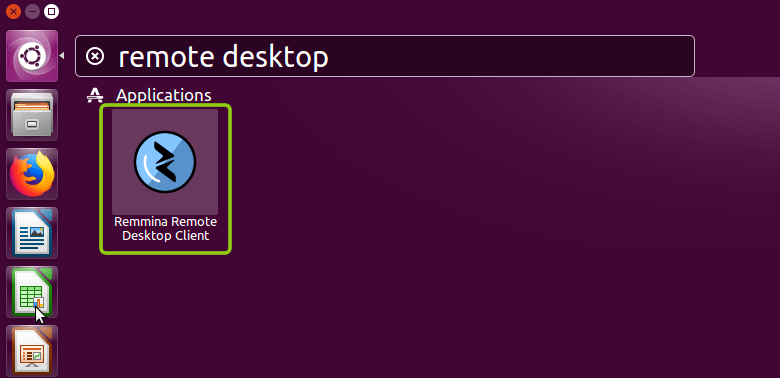
Remmina позволяет добавлять и сохранять список подключений для быстрого доступа к тому или иному серверу. Для сознания нового нажмите на «+», как показано на изображении:

Заполните поля авторизационными данными, которые
указаны в вашем личном кабинете
:
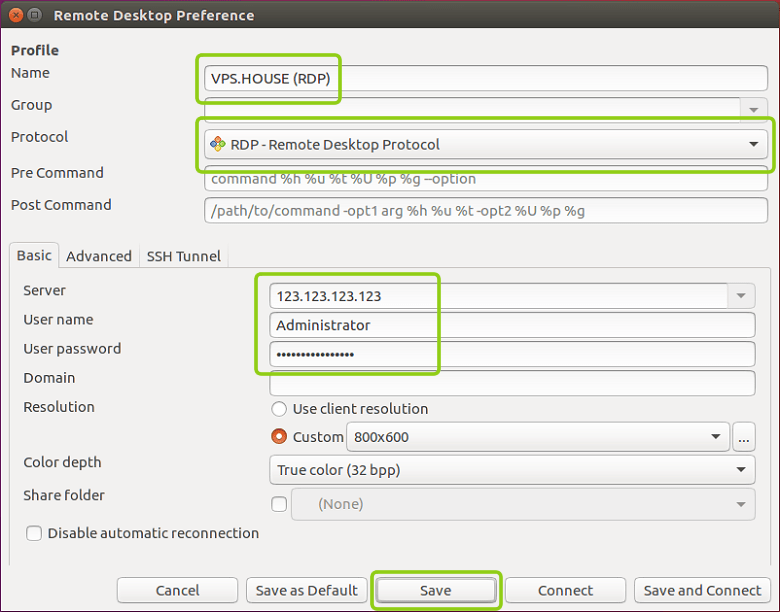
На вкладке «Advanced» вы можете также указать качество подключения к серверу и детализации при передаче изображений:
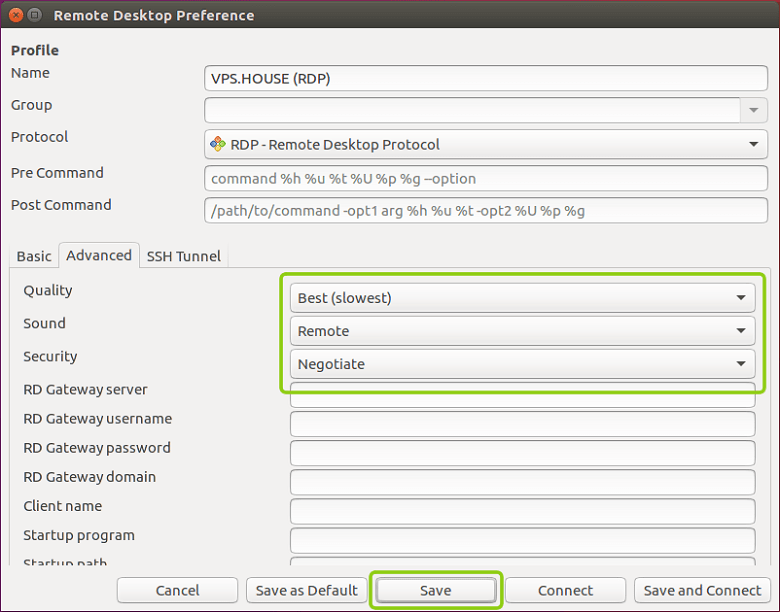
После сохранения данных вы всегда сможете найти ваш сервер в списке подключений Remmina. Для подключения к серверу теперь достаточно просто кликнуть дважды мышкой по строке сервера:

Если вы подключаетесь к серверу впервые с этого приложения, то оно может показать информацию о ошибке в сертификате безопасности. Почему это происходит
мы описали выше в блоке подключения к серверу из десктопной Windows
.
Достаточно нажать «ОК» и программа продолжит подключение к вашему серверу:
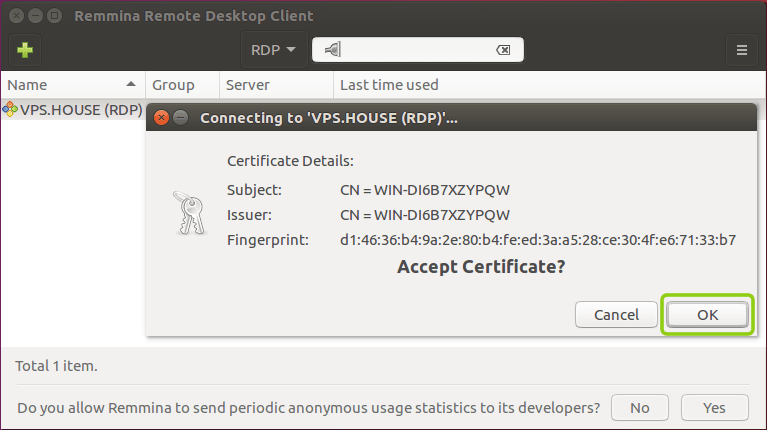

Как подключиться к серверу по RDP если вы работаете с Debian
Протокол RDP (Remote Desktop Protocol) – это закрытый протокол удалённого рабочего стола Microsoft. К сожалению, они не выпускают официальных клиентов для работы подключения к серверам Windows с операционных систем, работающих на базе Linux. Однако уже довольно давно существуют стабильно работающие решения.
Одно из самых популярных – это клиент для всевозможных удалённых Remmina, именно его мы и рекомендуем использовать для включения к серверам VPS.house или любым другим под управлением ОС Windows.

- Указываем путь к установочным файлам
echo 'deb http://ftp.debian.org/debian stretch-backports main' | sudo tee --append /etc/apt/sources.list.d/stretch-backports.list >> /dev/null - Запускаем процесс установки
sudo apt update - Устанавливаем плагин протокола RDP
sudo apt install -t stretch-backports remmina remmina-plugin-rdp remmina-plugin-secret libfreerdp-plugins-standard
Сразу после установки приложение можно найти через поиск программ:

В отличие стандартного от RDP-клиента ОС Windows, Remmina позволяет сохранять в список все свои подключения к различным серверам и осуществлять моментальный доступ к ним. Для добавления первого сервера в список нажмите «+» в левом верхнем углу:

В открывшемся окне задайте параметры подключения к вашему серверу и введите удобное для запоминания имя сервера. Все необходимые для подключения данных указаны в вашем личном кабинете:

На вкладке «Advanced» («Дополнительные») вы можете задать параметры передачи звука с сервера на ваш ПК, а также качество передаваемого изображения при подключении:

После сохранения я настроек вы увидите новую строку в списке подключений. Для начала работы с сервером достаточно просто дважды кликнуть по нему мышкой:
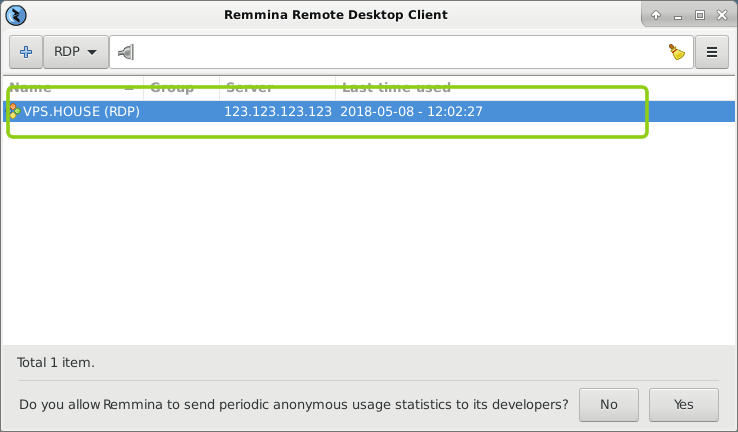
В момент первого подключения к серверу Remmina покажет уведомление у недоверенном сертификате шифрования. Это не является какой-либо ошибкой или проблемой безопасности. Причину этого сообщения мы описали выше. Просто нажмите «ОК» и вы увидите рабочий стол вашего сервера, при условии, разумеется, что все данные для подключения ранее были введены корректно.


Подключение серверу по RDP из Mac OS
Для подключения к удалённому рабочему столу для Mac OS компания Microsoft разработала и поддерживает официальный RDP-клиент. Он стабильно работает с любыми версиями ОС Windows.
Для загрузки его перейдите на сайт iTunes: https://itunes.apple.com/gb/app/id715768417
Программа обладает интуитивно понятным интерфейсом и позволяет создавать список серверов для дальнейшего моментального подключения к ним.
Для добавления нового сервера в список нажмите «New», как показано на скриншоте:
В открывшемся окне укажите авторизационные данные, как указано
в вашем личном кабинете
(IP-адрес сервера, логин Administrator и его пароль), и укажите произвольное название для нового подключения (Connection Name).
По завершению ввода нажмите на кнопку закрытия окна – все данных сохранятся и появится строчка с вашим сервером в списке подключений:

Кликните на эту строчку дважды мышкой, и вы подключитесь к серверу.
При попытке подключения к вашему VPS серверу если он работает на Windows Server 2008 или более новой версии, программа покажет уведомление о том, что не удалось проверить сертификат шифрования. Это не является проблемой безопасности, а всего лишь говорит о том, что сертификат выдан не сертифицированным центром, а сгенерирован самим же сервером.
Для того, чтобы это сообщение в будущем не возникало для этого сервера, нажмите «Показать сертификат».

Отметьте галочкой «Всегда доверять…» и нажмите «Continue».

Если в настройках подключения все параметры были введены без ошибок (IP-адрес, логин и пароль), то вы сразу же увидите рабочий стол вашего Windows Server:
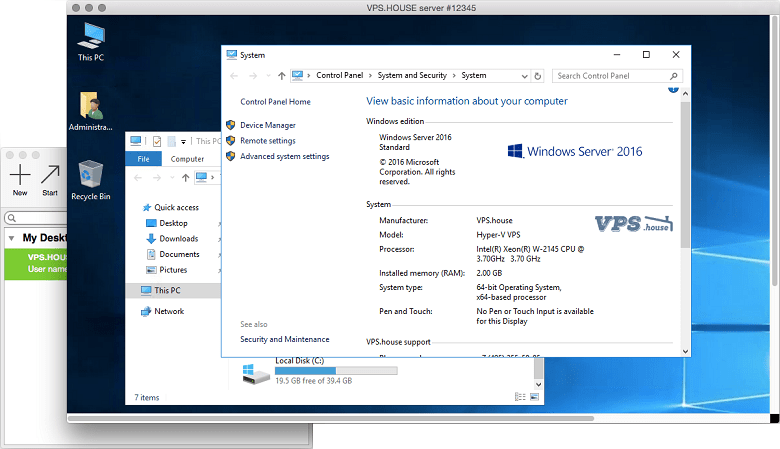
Подключение к VDS серверу со смартфона или планшета на iOS (с iPhone или iPad)
Для iOS копания Microsoft выпускает полноценный официальный RDP-клиент комфортного и стабильного подключения к удалённому рабочему столу. Приложение называется Microsoft Remote Desktop или Удаленный рабочий стол: https://itunes.apple.com/ru/app/id714464092
Microsoft Remote Desktop позволяет заранее настроить целый список используемых вами для частого подключения серверов.
Специфика его работы заключается в том, что информация об учётных записях создаётся и хранится отдельно от самого списка серверов. Соответственно, для начала нам требуется добавить учётную запись пользователя Administrator. Для этого нажмите на кнопку настроек (иконка шестерёнок в верхнем левом углу) и выберите «Учётные записи»:
В открывшемся окне нажмите на «Добавление учётной записи пользователя» и введите логин Administrator и его пароль, как отображается
в вашем личном кабинете
:
По завершению вы увидите, что учётная запись Administrator добавлена в список, далее нажмите кнопку «Готово» и вы вернетесь на стартовый экран.
Следующим шагом добавляется непосредственно информация о самом сервере. Нажмите кнопку «+» в правом верхнем углу приложения и в открывшемся меню выберите «Рабочий стол»:
В окне добавления нового подключения укажите IP-адрес вашего сервера и выдерите учётную запись Administrator, добавленную на прошлом шаге:
В момент первого подключения вы увидите уведомление вы увидите уведомление о недоверенном сертификате безопасности. Причину этого
мы описали выше
. Выдерите «Больше не спрашивать для этого ПК» и нажмите «Принять».

В случае если IP-адрес и авторотационные данные указаны без ошибки, вы успешно подключитесь к вашему виртуальному серверу:

Как подключиться к VPS серверу со смартфона или планшета на Android
Для устройств под управлением Android компания Microsoft выпускает полноценное приложение для работы с удалённым рабочим столом – Microsoft Remote Desktop. Скачайте его как любое другое приложение в
Google Play
.
В отличие от всех описанных выше приложений для подключений с ПК, мобильное приложение Microsoft Remote Desktop разделяет учётные записи и сам список подключений. Поэтому сначала нужно добавить в список учётную запись пользователя Administrator с его паролем, который показан
в вашем личном кабинете
:
После добавления учётной записи возвращайтесь на главный экран приложения для добавления самого подключения (адреса вашего VDS сервера):
В открывшемся окне укажите IP-адрес вашего сервера (указан в
личном кабинете
), выберите добавленную ранее учётную запись Administrator и нажмите «Сохранить» («Save»):
На главном экране в списке подключений появится ваш сервер, просто нажмите на него, и программа начтёт подключение. Если вы подключаетесь с этого приложения к серверу впервые, то увидите информационное сообщение о том, что приложению не удалось проверить сертификат шифрования. Почему так происходит
описано в начале статьи
.
Достаточно отметить галочкой «Never ask again for connections to this PC» и данное уведомление больше появляться не будет. Далее нажмите «Connect» и если все авторотационные данные и IP-адрес сервера указан без ошибок, вы успешно к нему подключитесь:

P.S.: У клиентов нашего VPS-хостинга часто возникает вопрос, как подключиться к серверу с того или иного устройства. В поисковиках можно найти все эти инструкции в том числе и с картинками, и с видео. Надеюсь, данная статья, будет полезной и здесь, как содержащая в одном месте инструкции по подключению со всех самых популярных устройств и операционных систем.
Have you ever used the Windows app Remote Desktop Connection? This app, included in all Windows installations, allows you to remotely access another Windows PC or a server with Windows Server. For this purpose, it employs the Remote Desktop Protocol (RDP).
Organizations can install applications on a central server instead of various computers. To use those applications, employees must remotely access that server. Such centralization can make maintenance and troubleshooting easier. This technology was formerly known as Terminal Services (TS). Currently, web systems are more common. But, in some scenarios, Windows remote apps are still needed.
In those scenarios, Linux users can remotely access Windows computers and servers from their favorite system using an RDP client.
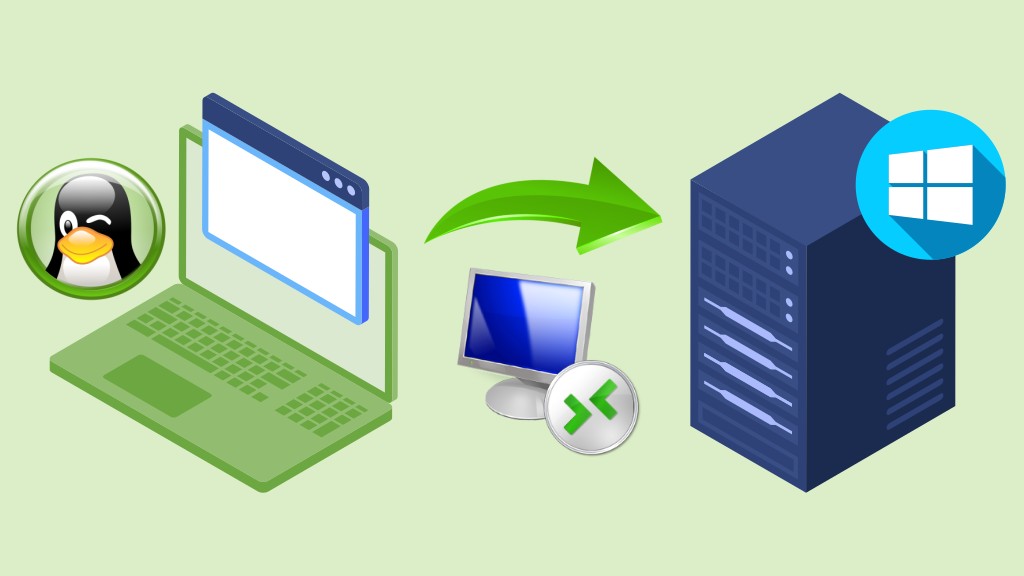
There are a few RDP clients available for Linux and we are going to talk about them today:
- Remmina
- FreeRDP
- rdesktop
- Vinagre
You can choose the one you like best or the one that best suits your needs.
Out of curiosity, FreeRDP is both an app and a library, which provides reusable features for other apps. Except for rdesktop, all of the other clients above use the FreeRDP library.
Enabling remote desktop on Windows
First of all, you must set up the computer you want to connect to so it allows remote connections. On the Windows machine you want to connect to, logged on with an administrator account, open the Start menu and click Settings. To do that, on the window that appears, open the System category, and then Remote Desktop. Finally, enable it:
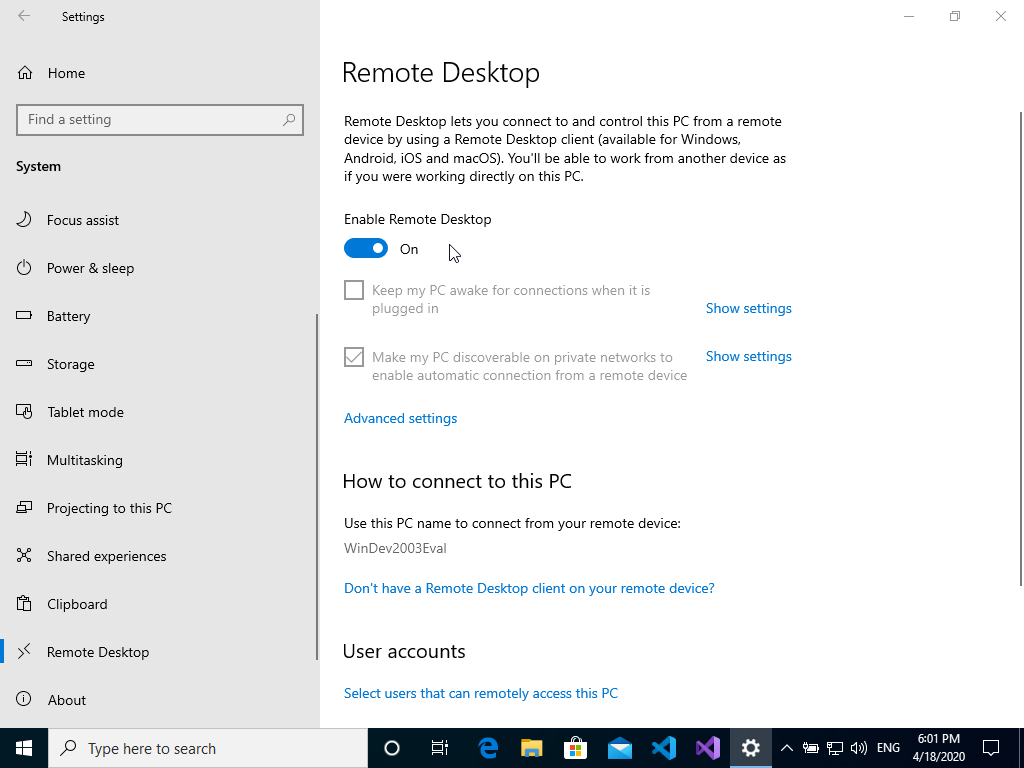
Note that you can’t connect to computers running a Windows Home edition (for instance, Windows 10 Home). This screen informs you, if that is the case:
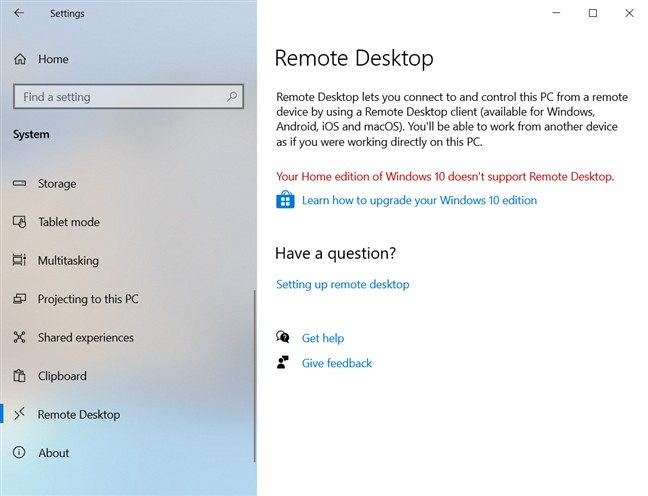
Your Home edition of Windows 10 doesn’t support Remote Desktop.
Source of the image: Digital Citizen
If you want more information about remote desktop on Windows, take a look at:
- How to use Remote Desktop — Windows Support
- Remote Desktop — Allow access to your PC — Microsoft Docs
Remmina is a remote desktop client that supports many remote access protocols such as RDP, VNC, NX, XDMCP and SSH. It aims to be useful for system administrators and travellers, who need to work with lots of remote desktops and/or servers. Remmina is included in the Ubuntu Linux distribution and is its default remote desktop client.
To install Remmina on Linux Kamarada and openSUSE, run:
1
# zypper in remmina remmina-plugin-rdp
Once installed, to start Remmina, if you use the GNOME desktop environment, open the Activities menu, on the top-left screen corner, type remmina and click its icon:
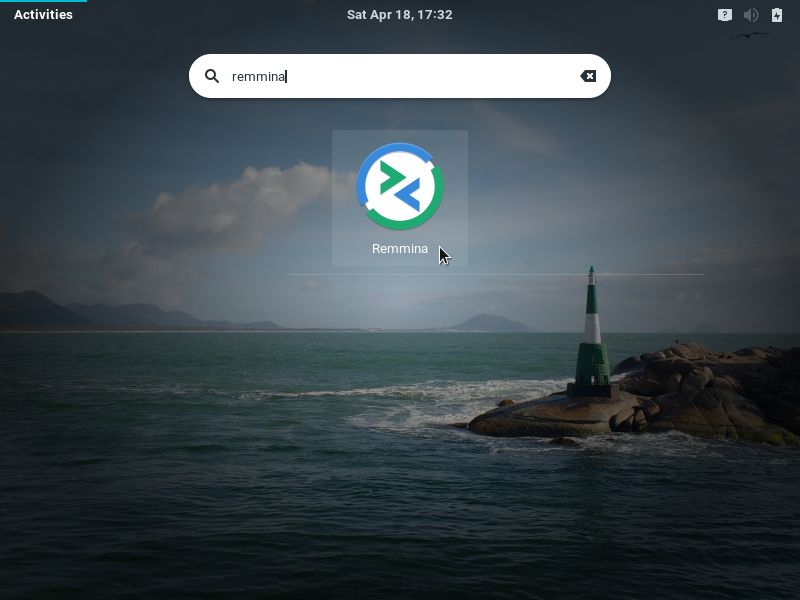
To quickly start a remote access, select the RDP protocol, type the hostname or IP address of the computer you want to connect to (e.g. 10.0.0.251) and hit Enter:
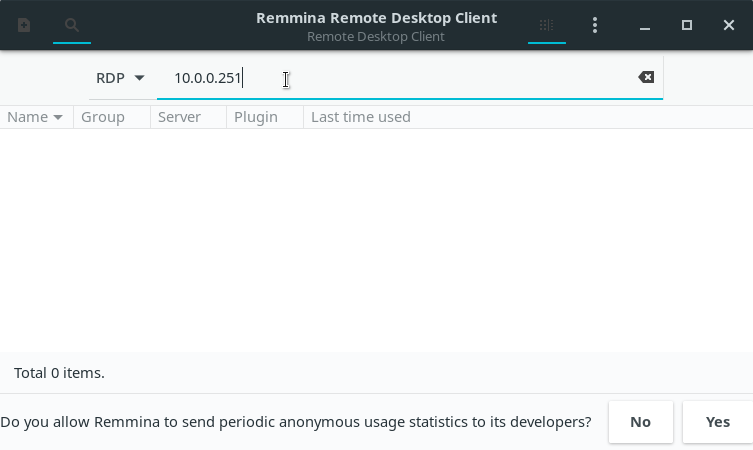
If it’s the first time you connect to this computer, Remmina asks whether to trust its certificate, click Yes:
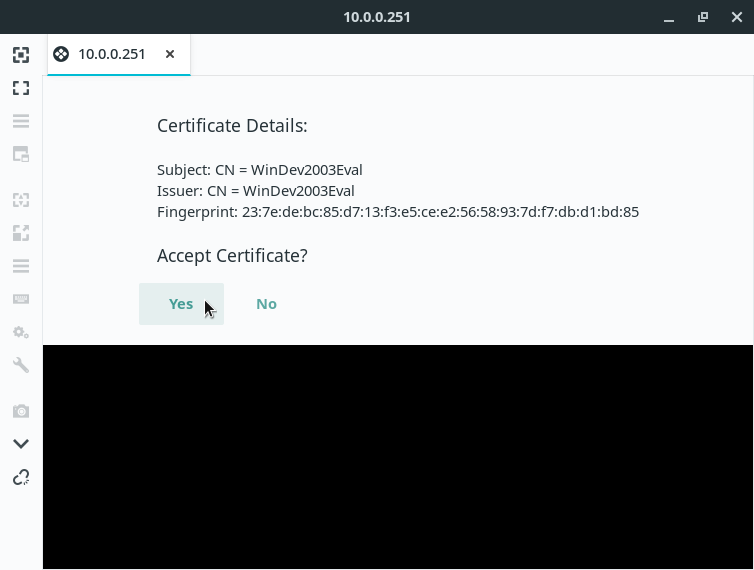
On the next screen, enter your User name and Password on the remote computer. Also inform the Domain, if necessary. Optionally, you can choose to Save password. Click OK:

You will see the remote computer’s desktop in the Remmina window:

From now on, you are using that computer, but remotely, without sitting in front of it. Each clicking and typing is sent to be processed on the remote computer.
If the remote computer is a Windows desktop, its screen is locked during remote access.
If you are going to access this computer often, consider saving the connection settings, so that remote access can be easily initiated. To do this, click the Create a new connection profile button on the top-left corner of the Remmina main window:
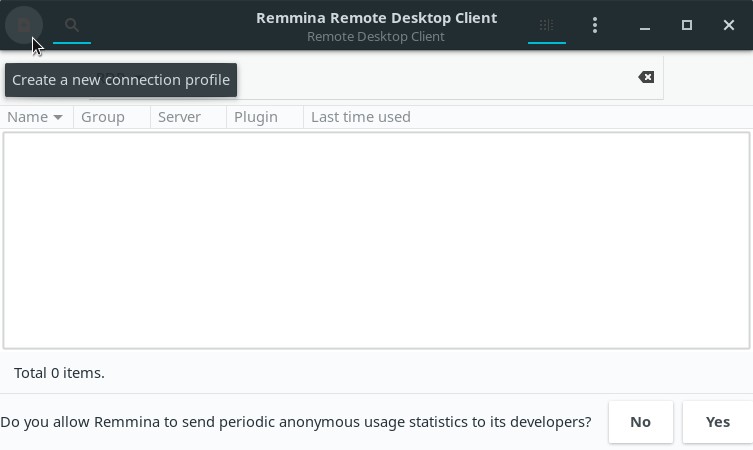
On the next screen, give a Name to identify the connection, select RDP in the Protocol field and enter the connection settings: Server, User name, User password and Domain (if necessary). When you’re finished, click Save:
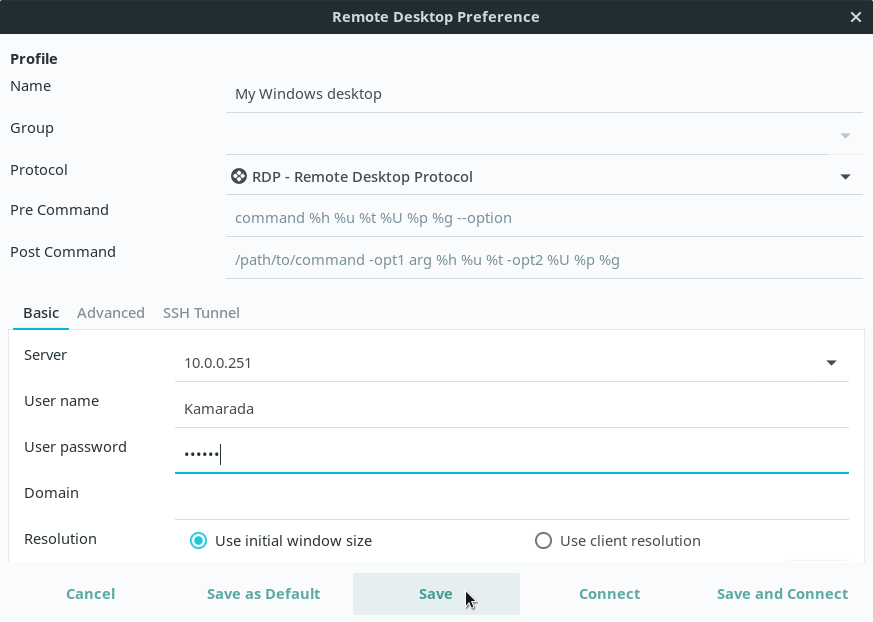
After that, the connection becomes listed on the Remmina main window:
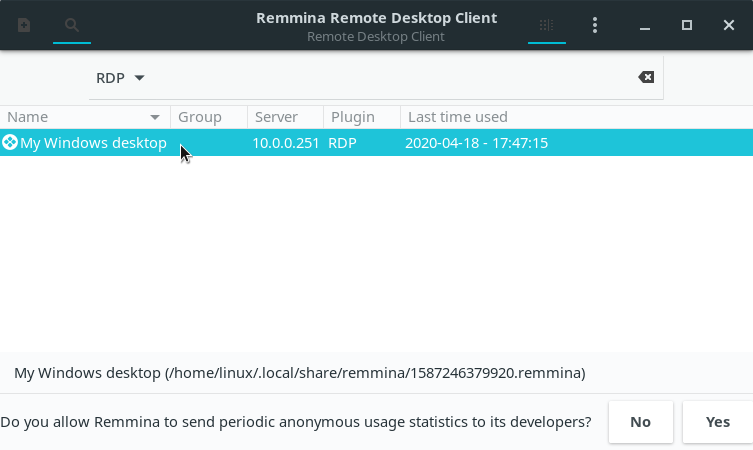
When you want to remotely access that computer, just double-click it on the list.
FreeRDP is a free implementation of the Remote Desktop Protocol following the Microsoft Open Specifications. This implementation provides both the client and the server applications as well as a library, which allows other applications to use the RDP protocol. Today, we are interested in the FreeRDP client application.
To install the FreeRDP client on Linux Kamarada and openSUSE, run:
The FreeRDP client does not have a main screen like Remmina. To start a remote access using the FreeRDP client, run this command from a terminal:
1
$ xfreerdp /v:hostname_or_ip_address /u:username
Making the appropriate substitutions. For example:
1
$ xfreerdp /v:10.0.0.251 /u:Kamarada
If you need to inform the computer’s domain, use the /d parameter:
1
$ xfreerdp /v:hostname_or_ip_address /d:domain /u:username
If it’s the first time you connect to this computer, the FreeRDP client asks whether to trust its certificate:
1
2
3
4
5
6
7
8
9
10
11
12
13
14
15
16
17
18
19
20
[18:10:18:588] [3213:3214] [INFO][com.freerdp.client.common.cmdline] - loading channelEx cliprdr
[18:10:18:604] [3213:3214] [INFO][com.freerdp.crypto] - creating directory /home/linux/.config/freerdp
[18:10:18:604] [3213:3214] [INFO][com.freerdp.crypto] - creating directory [/home/linux/.config/freerdp/certs]
[18:10:18:604] [3213:3214] [INFO][com.freerdp.crypto] - created directory [/home/linux/.config/freerdp/server]
[18:10:18:613] [3213:3214] [ERROR][com.freerdp.crypto] - @@@@@@@@@@@@@@@@@@@@@@@@@@@@@@@@@@@@@@@@@@@@@@@@@@@@@@@@@@@
[18:10:18:613] [3213:3214] [ERROR][com.freerdp.crypto] - @ WARNING: CERTIFICATE NAME MISMATCH! @
[18:10:18:613] [3213:3214] [ERROR][com.freerdp.crypto] - @@@@@@@@@@@@@@@@@@@@@@@@@@@@@@@@@@@@@@@@@@@@@@@@@@@@@@@@@@@
[18:10:18:613] [3213:3214] [ERROR][com.freerdp.crypto] - The hostname used for this connection (10.0.0.251:3389)
[18:10:18:613] [3213:3214] [ERROR][com.freerdp.crypto] - does not match the name given in the certificate:
[18:10:18:613] [3213:3214] [ERROR][com.freerdp.crypto] - Common Name (CN):
[18:10:18:613] [3213:3214] [ERROR][com.freerdp.crypto] - WinDev2003Eval
[18:10:18:613] [3213:3214] [ERROR][com.freerdp.crypto] - A valid certificate for the wrong name should NOT be trusted!
Certificate details:
Subject: CN = WinDev2003Eval
Issuer: CN = WinDev2003Eval
Thumbprint: 23:7e:de:bc:85:d7:13:f3:e5:ce:e2:56:58:93:7d:f7:db:d1:bd:85
The above X.509 certificate could not be verified, possibly because you do not have
the CA certificate in your certificate store, or the certificate has expired.
Please look at the OpenSSL documentation on how to add a private CA to the store.
Do you trust the above certificate? (Y/T/N)
Type Y (yes) and hit Enter. Then type your user password on the remote computer and hit Enter:
1
2
3
4
5
Do you trust the above certificate? (Y/T/N) Y
Password:
[18:11:31:595] [3213:3214] [INFO][com.freerdp.gdi] - Local framebuffer format PIXEL_FORMAT_BGRX32
[18:11:31:596] [3213:3214] [INFO][com.freerdp.gdi] - Remote framebuffer format PIXEL_FORMAT_RGB16
[18:11:32:782] [3213:3214] [INFO][com.winpr.clipboard] - initialized POSIX local file subsystem
After that, the remote desktop connection is initiated:
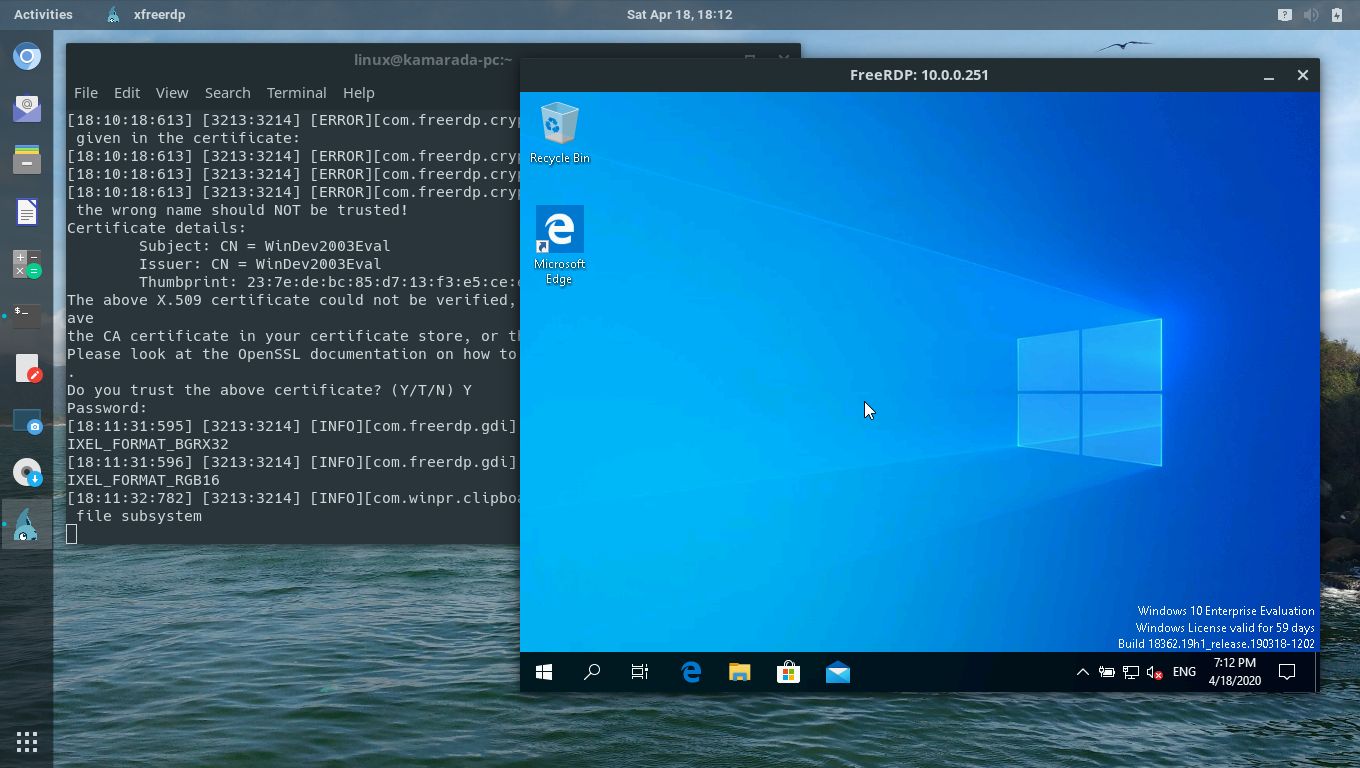
If you have ever started the remote desktop connection on Windows by the Command Prompt (using the mstsc command), you may have noticed that the FreeRDP client uses the same command syntax. It was implemented that way on purpose, to keep compatibility.
If you are a curious person and want to check it out by yourself:
- on Windows, run:
- on Linux, run:
rdesktop was the first RDP client for Linux and, for many years, it was the most used. But since November 2019, the project is looking for a new maintainer.
In contrast, FreeRDP was born in 2009 as a fork of rdesktop, when Microsoft decided to open the RDP specifications. As time passed and the FreeRDP project evolved, it became the standard RDP client on systems where no native Microsoft client is available.
I present rdesktop here for information purposes only. Unless you have a good reason to use it, you are advised to use one of the other RDP clients, based on FreeRDP.
To install rdesktop on Linux Kamarada and openSUSE, run:
Then, to start a remote access using rdesktop, invoke it from a terminal followed by the hostname or IP address of the computer you want to connect to. For example:
In the past, that would suffice and rdesktop would just work. But now we face a problem that comes from the lack of proper maintenance and updates:
1
2
3
Autoselected keyboard map en-us
ERROR: CredSSP: Initialize failed, do you have correct kerberos tgt initialized ?
Failed to connect, CredSSP required by server.
At some point, Microsoft released an Windows update that has since made the use of Network Level Authentication (NLA) required by default. FreeRDP does support NLA, while rdesktop does not. You can still use rdesktop for remote access, as long as you disable NLA on the computer you want to connect to. Note that this makes the connection less secure.
To disable NLA on the Windows machine you want to connect to, logged on with an administrator account, open the Control Panel, open the System and Security category, then click the System icon. On the next screen, click the Remote settings link by the left. On the dialog box that appears, select the Remote tab. Finally, disable the option Allow connections only from computers running Remote Desktop with Network Level Authentication and click OK:
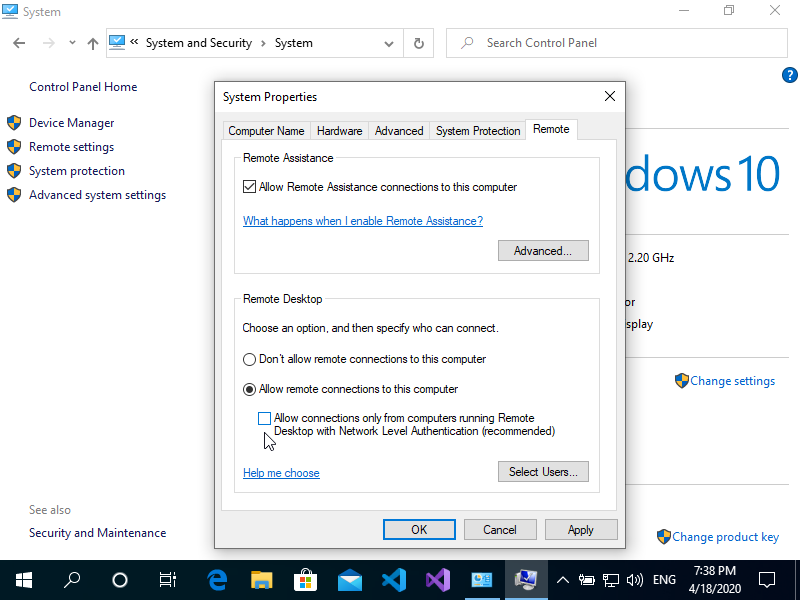
With NLA disabled, back to the Linux computer that will start the remote access, try again:
This time, rdesktop will work. A window presents the Windows logon screen. Enter your username and password and press Enter to start the remote access:
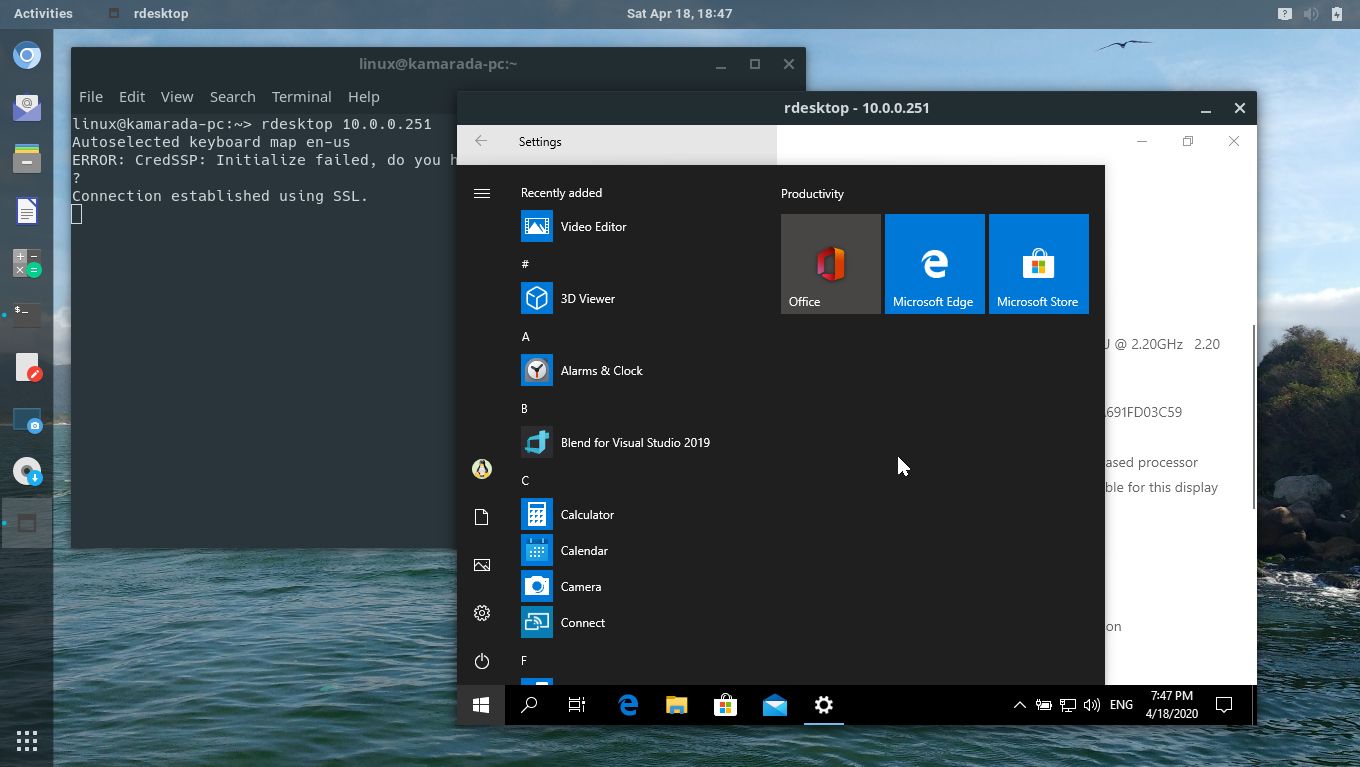
If you want more information about that rdesktop bug, see:
- CredSSP does not work — Issue #71 — rdesktop/rdesktop — GitHub
- Add support for Network Level Authentication — Issue #279 — rdesktop/rdesktop — GitHub
- Doesn’t work if there is Fortress machine between connecting to the remote server — Issue #261 — rdesktop/rdesktop — GitHub
- Network Level Authentication (NLA) — rdesktop/rdesktop Wiki — GitHub
Vinagre is the default remote desktop client for the GNOME desktop. That’s why it is also the default remote desktop client for Linux Kamarada 15.1, the current stable release. Like Remmina, it supports some connection protocols: SSH, RDP, SPICE and VNC. However, like rdesktop, Vinagre is unmaintained for some time now.
When trying a RDP access, Vinagre only displays a black screen, as I reported on the openSUSE mailing list some time ago:
- [opensuse-factory] Black screen when trying a RDP access to Windows 10 using Vinagre (Leap 15.1/15.2 and Tumbleweed)
On some distributions, like Debian, Vinagre works. I believe that those distributions applied some patch to Vinagre.
Probably, the next Linux Kamarada release will come with Remmina instead of Vinagre, following the Ubuntu Linux distribution.
Because of that, I present Vinagre here just for information purposes as well.
Vinagre comes already installed by default on Linux Kamarada and openSUSE, if you chose the GNOME desktop, but if you need or want to install it, you can do this by running:
To start Vinagre, which appears as Remote Desktop Viewer on the applications list, open the Activities menu, on the top-left screen corner, type remote or vinagre and click the corresponding icon:
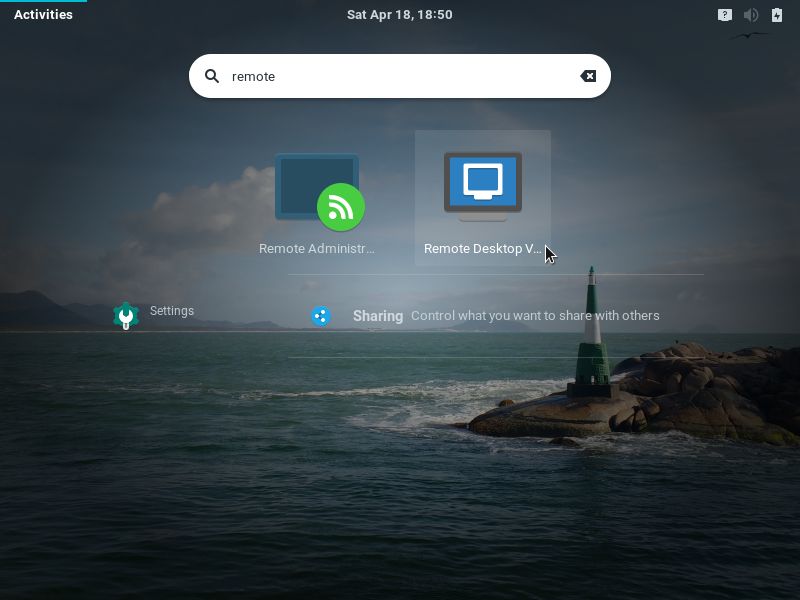
On the Vinagre main screen, click Connect:
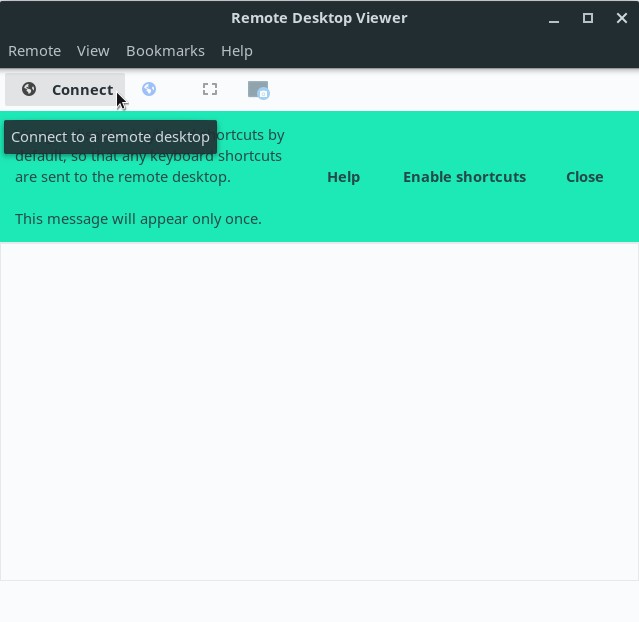
Fill in the next screen fields with the connection settings:

- on the Protocol field, select RDP;
- on the Host field, enter the hostname or IP address of the computer to connect to;
- enter your Username on the remote computer; and
- enter the Domain, if necessary.
When you are finished, click Connect.
If it’s the first time you connect to this computer, Vinagre asks whether to trust its certificate:
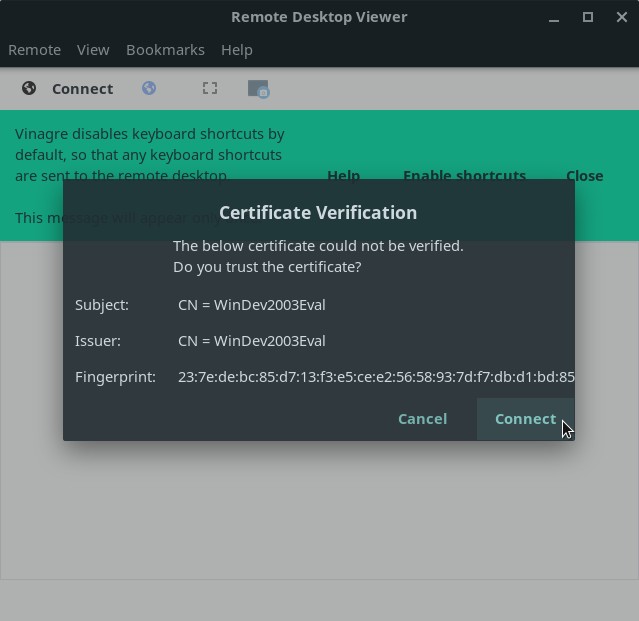
Tell it to do so by clicking Connect.
Enter your Password, optionally enable Remember this credential and click Authenticate:
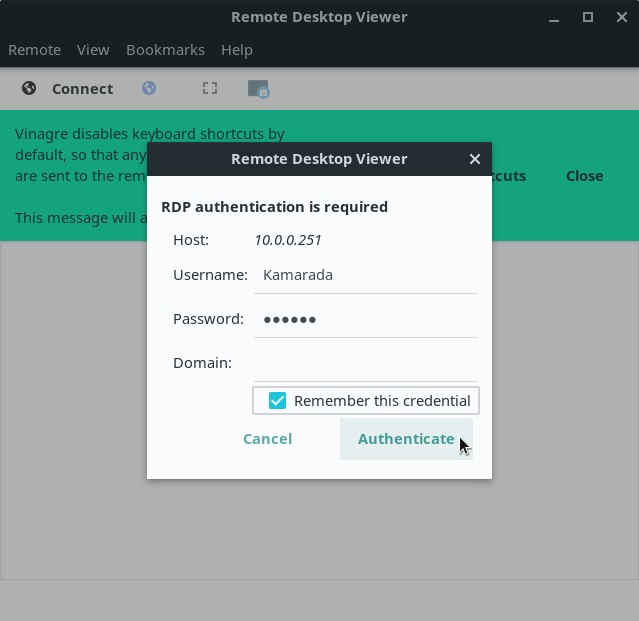
At this point, you should see the remote computer’s desktop. You can notice it has its screen locked (as it normally does during RDP accesses). But, as I said, Vinagre only displays a black screen:
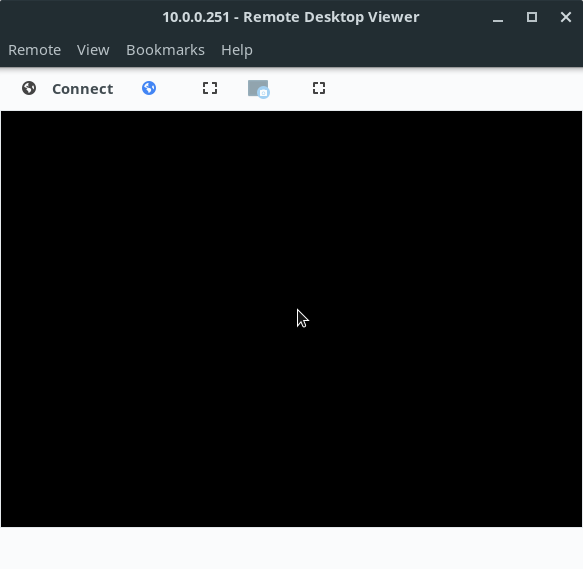
Like Remmina, Vinagre allows you to memorize the connection settings, to easily connect to the same computer again in the future. To do this, during the remote access, open the Bookmarks menu and click Add Bookmark.
After you created the bookmark, it will now be listed on the Bookmarks menu. When you want to remotely access this computer again, just open this menu and click the bookmark.
References
- How to use Remote Desktop — Windows Support
- Remote Desktop — Allow access to your PC — Microsoft Docs
- Remote Graphical Sessions with VNC — Reference — openSUSE Leap 15.1
- Hi! — The history of the FreeRDP project — FreeRDP
Since it’s not possible to remotely access computers running Windows 10 Home, to write this how-to I used a VirtualBox virtual machine with a Windows 10 Enterprise evaluation version legally downloaded from:
- Download a Windows 10 virtual machine — Windows app development
Для того, чтобы подключиться к виртуальному серверу Windows из операционной системы linux (в данном примере будет Ubuntu), требуется установить клиент удалённого доступа Remmina
sudo apt-get update
sudo apt-get install remmina remmina-plugin-rdpЛибо можно точно так же установить всё это через менеджер пакетов Synaptic:

После установки запускаем remmina и настраиваем подключение к удалённому серверу.
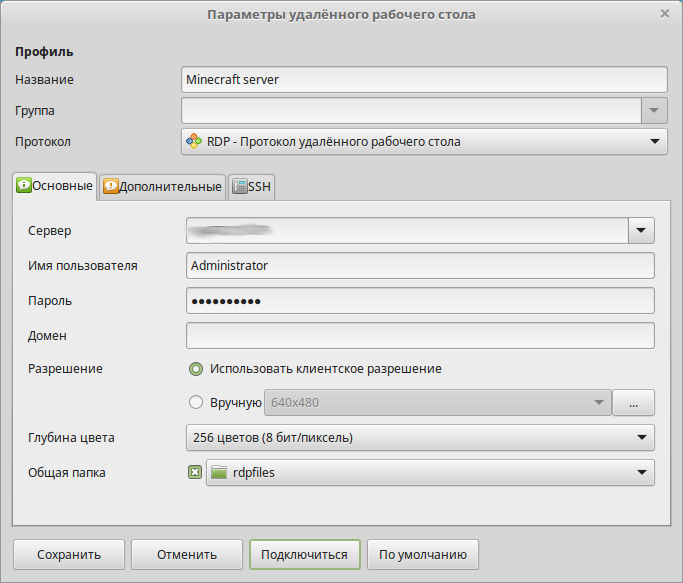
В поле “Сервер” вписываете ip-адрес вашего сервера, имя пользователя сервера и пароль, который вам выдали при создании.
Параметр “Глубина цвета” следует задать таким, чтобы соединение не тормозило. Часто возникает ошибка, если его поставить слишком большим.
Вы можете копировать фалы из этой сетевой папки в папки на сервере и обратно. Для того, чтобы файлы возможно было копировать на сервер, можно задать общую папку, в данном примере имя папки “rdpfiles”.
Не забываем сохранить подключение, с соответствующим именем.
После первого подключения, вам предложат принять сертификат. Соглашаемся с этим.

После подключения и всех настроек, можно будет управлять удалённым VPS-сервером. Подключённая папка будет доступна через проводник.

Либо, в случае, если у сервера нет графического интерфейса, то через PowerShell по адресу
\\TSCLIENT\rdpfilesОбратите внимание, что имя папки дано для примера. В вашем случае это имя может быть отличное от “rdpfiles”, но в любом случае это будет подпапка папки \\TSCLIENT .
Из обнаруженных проблем, клиента Remmina – иногда некорректно монтируется удалённая папка и сервер её не видит. Для этого необходимо полностью отключить клиент Remmina (в том числе выйти из фоновой версии программы) и перезапустить её. Тогда подключение работает корректно.
